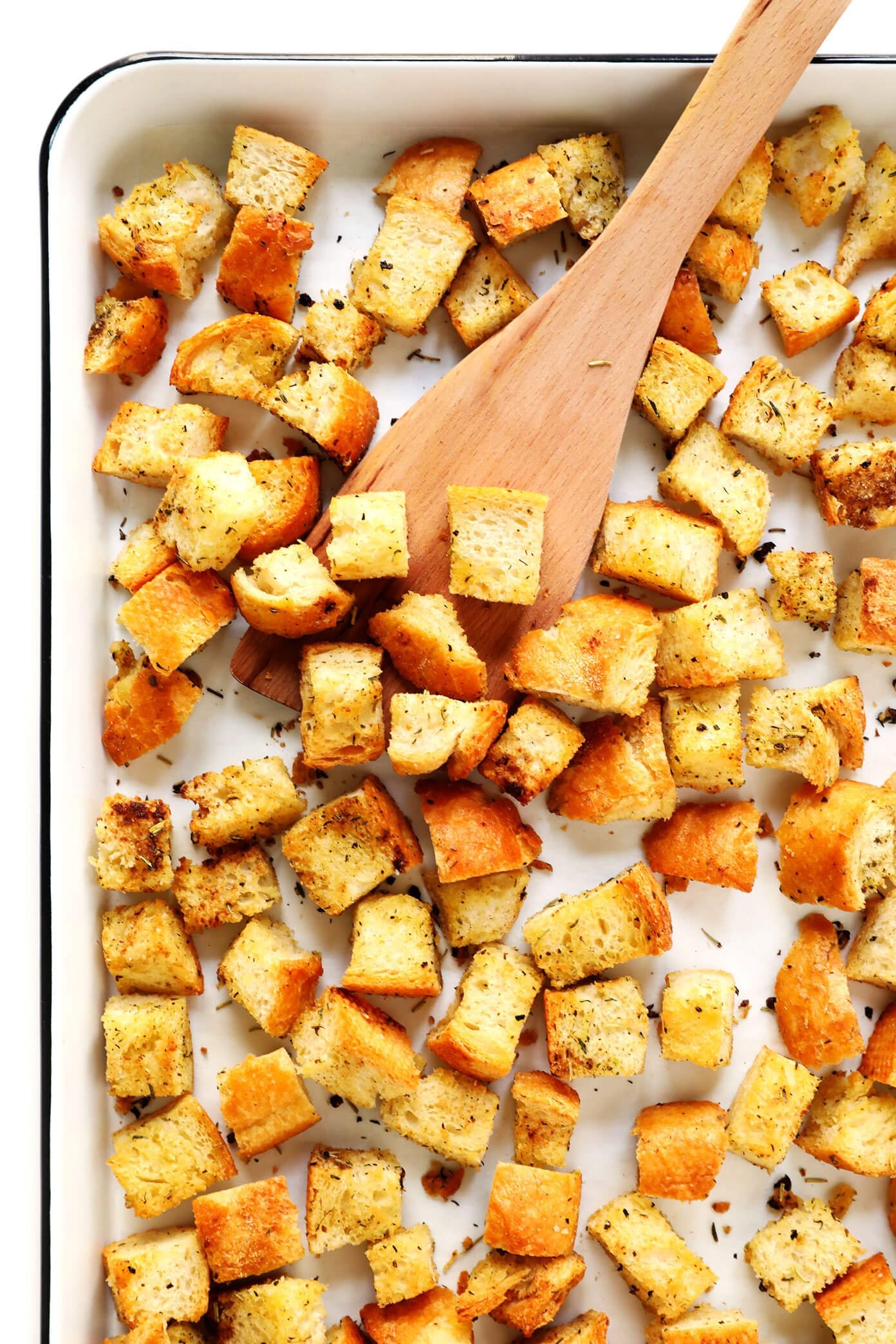Have some day-old bread lying around? Turn it into golden, crunchy perfection! This guide will show you how to make homemade croutons that are far superior to anything store-bought. We’re diving into the simple steps to create croutons that are not only incredibly tasty but also customizable to your exact preferences. Whether you crave garlic-infused bites, Italian-herb seasoned crunch, or just simple, perfectly crisp bread cubes, we’ve got you covered. Get ready to elevate your salads, soups, and snacks with these easy-to-make homemade croutons.
 Golden homemade croutons piled on a wooden surface, showcasing their crispy texture and inviting color.
Golden homemade croutons piled on a wooden surface, showcasing their crispy texture and inviting color.
Why Make Homemade Croutons?
Let’s be honest, store-bought croutons are often dry, flavorless, and overly processed. Making your own homemade croutons is a game-changer for several reasons:
- Unbeatable Flavor: Freshly baked croutons have an unparalleled flavor and aroma that pre-packaged versions simply can’t match. You control the seasonings, ensuring a taste that perfectly complements your dish.
- Superior Texture: Achieve the ideal crispiness level – from slightly chewy to intensely crunchy – tailored to your liking. Homemade croutons avoid the often stale and hard texture of store-bought alternatives.
- Cost-Effective & Zero Waste: Utilize leftover bread that might otherwise go to waste. Making croutons at home is significantly cheaper than buying them, especially if you bake bread regularly.
- Customization Galore: Experiment with different breads, oils, and seasonings to create endless variations. Garlic, herbs, cheese, spices – the possibilities are limitless!
- Freshness Guaranteed: Enjoy croutons at their peak freshness. Homemade croutons are best enjoyed soon after baking, offering a delightful crunch and flavor that diminishes over time in packaged products.
Ingredients for Homemade Croutons: Simple and Versatile
The beauty of homemade croutons lies in their simplicity. You only need a few basic ingredients, and the recipe is incredibly adaptable to what you have on hand:
- Bread: The star of the show! Day-old bread is ideal as it’s slightly dried out, which helps achieve crispier croutons. However, fresh bread will also work – you might just need to bake them a bit longer to remove excess moisture. Almost any type of bread can be used:
- French or Italian Loaf: Classic choices providing a good structure and neutral flavor.
- Sourdough: Adds a tangy flavor dimension.
- Whole Wheat: Offers a nuttier taste and denser texture.
- Gluten-Free Bread: Perfect for dietary needs, just ensure it’s a sturdy loaf.
- Even Bagels or Buns: Get creative and use what you have!
- Oil: Oil helps the croutons crisp up beautifully and adds flavor.
- Olive Oil: A traditional and healthy option, imparting a subtle fruity note.
- Melted Butter: For richer flavor and extra golden-brown color.
- Avocado Oil or Coconut Oil: Neutral oils that work well if you prefer a less pronounced flavor.
- Seasonings: This is where you can truly customize your croutons! Start with the basics and then get creative:
- Salt & Pepper: Essential for enhancing flavor. Use sea salt or kosher salt for best results. Freshly ground black pepper is always preferable.
- Garlic Powder: A must-have for many crouton lovers, adding savory depth.
- Italian Seasoning: A blend of dried herbs like oregano, basil, rosemary, and thyme, perfect for an Italian-inspired flavor.
- Onion Powder: Adds a subtle sweetness and savory note.
- Dried Herbs (Rosemary, Thyme, Oregano, Basil): Use individually or in combinations to create your signature blend.
- Spices (Paprika, Chili Powder, Cayenne Pepper): For a touch of warmth or spice.
- Parmesan Cheese (Grated): Sprinkle on before baking for cheesy, savory croutons.
Step-by-Step Guide: How to Make Croutons in the Oven
Making croutons in the oven is incredibly straightforward. Follow these simple steps for perfectly crisp results:
Step 1: Dice the Bread into Uniform Cubes
- Cut or Tear: You can either use a serrated knife to cut the bread into cubes or tear it into chunks by hand for a more rustic look.
- Size Matters: Aim for roughly ¾-inch to 1-inch cubes. Consistent size ensures even cooking. Smaller cubes will crisp up faster and become very crunchy, while larger cubes will have a slightly softer center.
- Dry Bread Advantage: If using very fresh bread, consider letting the cubes air dry for an hour or so to remove some moisture before proceeding. This will help them crisp up better in the oven.
Step 2: Season Generously and Toss Evenly
- Large Bowl is Key: Place the bread cubes in a large bowl to allow ample space for tossing and even coating.
- Drizzle with Oil: Pour the oil evenly over the bread cubes. Start with the recommended amount and add a bit more if needed to ensure all pieces are lightly coated.
- Seasoning Sprinkle: Sprinkle your chosen seasonings over the oiled bread.
- Toss Thoroughly: Use your hands or a large spoon to gently toss the bread cubes until they are evenly coated with oil and seasonings. Ensure no dry bread remains at the bottom of the bowl. Even coating is crucial for consistent flavor and crispiness.
Step 3: Bake to Golden Crispiness
- Preheat Oven: Preheat your oven to 375°F (190°C).
- Single Layer on Baking Sheet: Spread the seasoned bread cubes in a single layer on a baking sheet. Use parchment paper for easy cleanup, although it’s not strictly necessary. Avoid overcrowding the pan, as this will steam the croutons instead of baking them, preventing crispiness. Use two baking sheets if needed.
- Bake and Flip: Bake for 10-20 minutes, flipping the croutons halfway through. Baking time will vary depending on the bread type, cube size, and your desired level of crispiness.
- Watch Carefully: Keep a close eye on the croutons, especially during the last few minutes of baking, to prevent burning. They should turn golden brown and feel crisp to the touch. If they start to brown too quickly, reduce the oven temperature slightly.
Step 4: Cool Completely for Maximum Crunch
- Cooling Tray (Optional): Transfer the baked croutons to a wire cooling rack to allow air to circulate and prevent the bottoms from becoming soggy. If you don’t have a cooling rack, simply leave them on the baking sheet.
- Cool Completely: Allow the croutons to cool completely at room temperature. They will crisp up further as they cool.
- Storage (If Not Using Immediately): Once completely cooled, store the croutons in an airtight container at room temperature for up to a week. For optimal freshness, consume within a few days.
Delicious Ways to Use Your Homemade Croutons
Homemade croutons are incredibly versatile and can elevate a wide range of dishes:
- Salads: The classic pairing! Croutons add delightful crunch to any salad, especially Caesar salad, garden salad, or spinach salad.
- Soups: Float them on top of creamy tomato soup, butternut squash soup, French onion soup, or gazpacho for added texture and flavor.
- Stuffing and Dressings: Incorporate slightly softened croutons into your holiday stuffing or bread pudding for a delightful textural element.
- Casserole Toppings: Sprinkle crushed croutons over casseroles for a crispy, flavorful topping.
- Snacks: Enjoy seasoned croutons straight out of the container as a satisfying snack.
- Breadcrumbs: Pulse cooled croutons in a food processor to make homemade breadcrumbs for coating chicken, fish, or vegetables.
Enjoy the satisfaction of creating your own perfectly crispy and flavorful homemade croutons! They are a simple yet impactful way to enhance your everyday meals.

